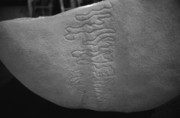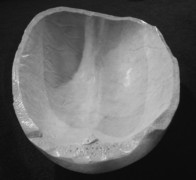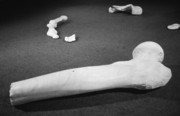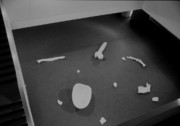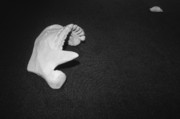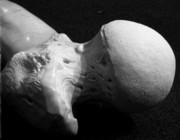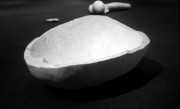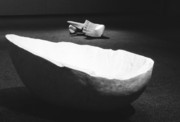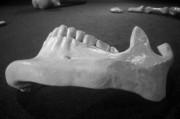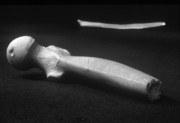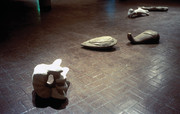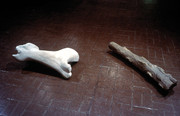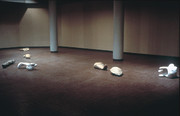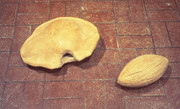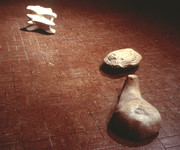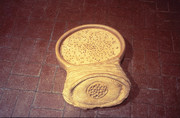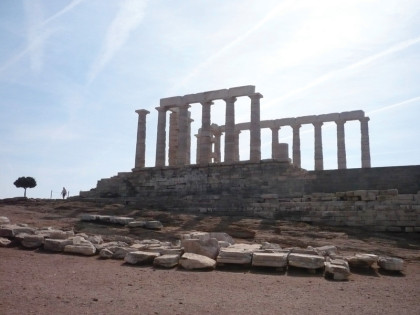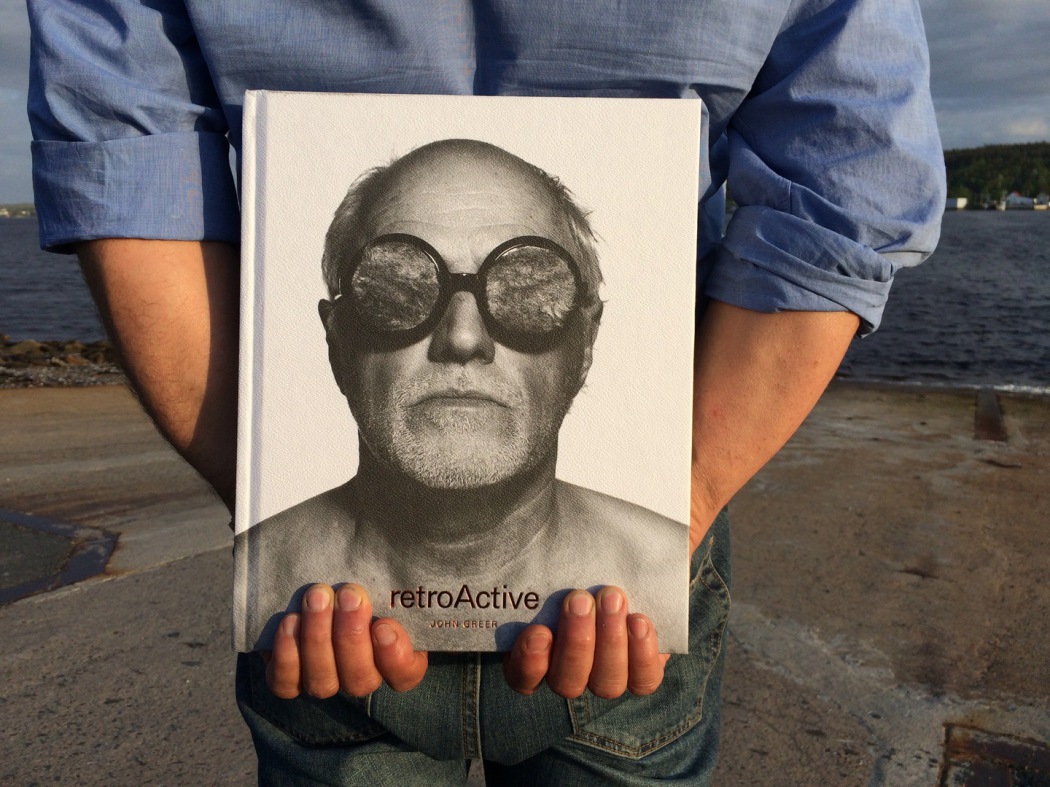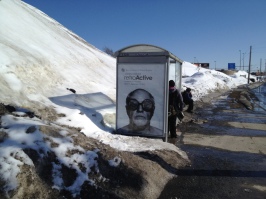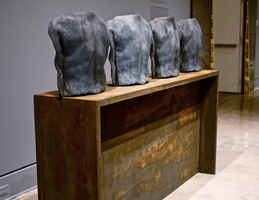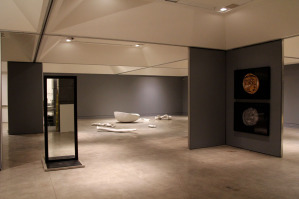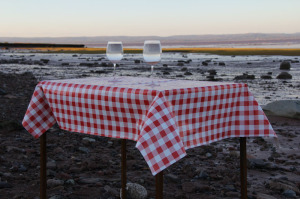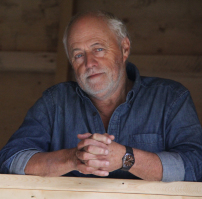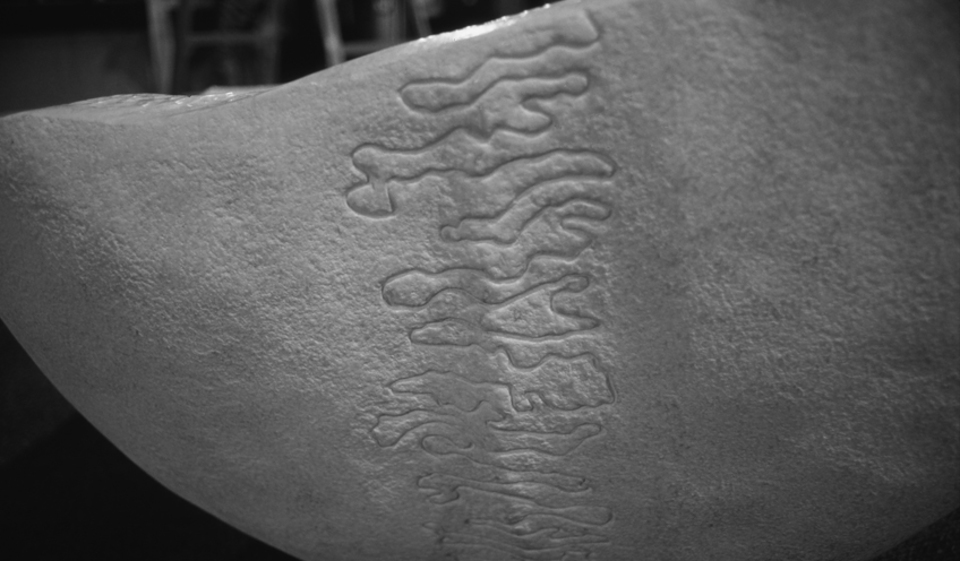
The World in Us
Avec une lumière pour voir comment je ne vois pas,
entre le déjà plus et le pas encore,
c'est la que j'ai été placé.
Eduardo Chillida
"Civilization is the state of having a high level of social organization, culture, and a comfortable way of life."(Collins). Greer's "Civilization" 1992 consists of 13 pieces of marble shaped in the form of specific bones of the human body, upscaled to a size that we relate to as furniture next to a human object.
The "bones" are functioning here as ideas, not as images. They stand for the ordinariness of every person walking on the earth. The work is upgrading this ordinariness of the normal person in opposition to the mystification of bones as relicts for the demonstration of a heroic act.
Facing our own mortality as vital element in our lives, we should be familiar with bones - not as reminiscent parts of a person, but as vital part of the body. Instead, bones do have a sacred meaning in our civilization; they are confined to the museum as sacrilege, loaded with meaning just by the course of time. History is developing relations and is defining a concise pattern of historical facts. For John Greer, historical facts are fiction. As mentioned in the preceding chapter, his understanding explains history as a record of subjective positions, and because of that as a (necessary) construct that is apart from reality. Foucault writes in "Die Ordnung der Dinge" (The order of things): "Since man is just devoting himself to positive knowledge by talking, working and living, could history be something else but a knot of different foreign times, and heterogeneous to each other, that can not be disentangled?" (Foucault)68. For him as well, history is a narration that is foreign to us. It is imposed on facts of life, because it exists only in verbal language and therefore can be changed, depending on the subjective point of view. For the artist, experience is visualized in form, that is, in natural forms, as much as in "cultural" articulation. As described earlier, for Greer, the correlating definition in opposition to history is memory.
(... text continued below images)
In our society, we grow up in the awareness of an existing dualism between mind and practice - an applied consideration of the human being as an ever-present point of criticism in Greer's body of work. With his art, he tries to make us aware of the fact that our mind has to operate through the body, which is - through experience. In his writings on "Art as Experience", John Dewey tries to give a definition of mind as a cornerstone of memory in order to describe the esthetic experience of a work of art. "In its non-technical use, "mind" denotes every mode and variety of interest in, and concern for, things: practical, intellectual, and emotional. It denotes all the ways in which we deal consciously and expressly with the situations in which we find ourselves."(John Dewey)69
He continues by describing that general thinking has changed the understanding of mind as activity into the acceptance of mind as an independent entity. He sees a danger in the fact that our society changed its way of responding to the environment, because it separated mind from time and space, from the world of matter and events. "This conception of mind as an isolated being underlies the conception that esthetic experience is merely something "in mind", and strengthens the conceptions which isolates the esthetic from those modes of experience in which the body is actively engaged with the things of nature and life. It takes art out of the province of the live creature." (John Dewey)70
As Dewey, Greer situates art in the immediate surrounding of the human being and works with means of form and object that make us reflect on being simply, but intensively alive. The exhibited marble-“bones” were carefully chosen in reference to their qualities of defining life processes and human action: mentality is captured by a brain-case, communication is represented by a jaw, as well as mobility by the femur, breath or spirit by the rib and dexterity by the thumb bones (they are arranged in a line in order to form a loose connection). The additional small, scattered elements reference a whole skeleton that is taken apart. The substantiality of the elements as sculptures and their inherent strength and vitality keeps them from becoming morbid or even sinister. In contrary, the richness of surface detail unfolds a field of associations that is closely tied to body experiences and relates to universal natural patterns. For example, the veining in the scull, which is reminiscent of the vein-pattern of leaves, is important as the negative form of a specific brain. It is a physical manifestation of thinking potential, an energy pool that is gone into the world. Many surface details of the "original" bones become important in relation to the living body, because of the difference in scale. Functional details receive tactile qualities.
The element of life inherent in a bone - its coming into existence from a core, the "fleshing out" in a body around it, is similar to the idea as such - a basic thought, becoming form and matter through human interaction versus reaction by natural development. Memory is the motor of continuance of form as matter and life. In that close proximity we can perceive a piece of art as an expression of continuance of memory. With the piece "Civilization", Greer subjectifies this force for a new reflection in experience. "Art is the most universal form of language, since it is constituted, even apart from literature, by the common qualities of the public world, it is the most universal and freest form of communication. Art is the extension of the power of rites and ceremonies to unite men, through a shared celebration, to all incidents and scenes of life. That art weds man and nature is a familiar fact. Art also renders men aware of their union with one another in origin and destiny." (John Dewey)71 With his carvings, Greer tries to capture a celebration of life, gives us an incentive to rediscover a common ground.
The artist's concern for time as opposing component to history seems to culminate in the described work, "Civilization". The cultural component is an overlapping process that merges with the nature of evolution. Here it is used to redefine the natural aspect of our human organization as thinking beings of the world. A last statement by Dewey sums up the relationship of art and civilization exemplarily: "The material of esthetic experience in being human - human in connection with the nature of which it is a part - is social. Esthetic experience is a manifestation, a record and celebration of the life of a civilization, a means of promoting its development, and is also the ultimate judgment upon the quality of a civilization.(...) There are transient and there are enduring elements in a civilization. The enduring forces are not separate; they are functions of a multitude of passing incidents as the latter are organized into the meanings that form minds. Art ist the great force in effecting this consolidation.(...) Continuity of culture in passage from one civilization to another as well as within the culture, is conditioned by art more than by any other thing." (John Dewey)72
Greer carefully crosses the border of such a definition and merges the experience of a work of art with its definition of humanity as an act of integration. He does that by using imagery that is ambivalent in its meaning as remaining part of a body and living part of a form of intelligence. This is only valid in connection to the scale that Greer uses. The pieces do have architectural sizes - and are meant as such - by referring to a structure as support of a system. The sculpture-object should not be misunderstood as image. A comparison with architecture is useful in order to describe this state of "being" - as objects among us. Dieter Rahn refers in that context in "Die Plastik und die Dinge" (The form (sculpture) and the things) to a "temple" as place - which is encouraging the visitor to move inside of the room and not to reflect upon it as an image. If one considers the temple as a sculptural building that comprises inherent spatial and formal relations, it opens up an understanding of sculpture (Plastik) as a spatial correlation: "The orbitary column-hall defines the Greek temple as a "plastic" (plastische) construction, not as a shell for an inner space. "Spatial" architecture in its familiar sense does only exist since the Pantheon in Rome was built. The column has the quality of an opening-up towards all directions. (...) Gravity, light, deformation and construction are confrontational without any subordination or preference. Neither does the temple become part of nature, nor is he denying or embellishing the wilderness. Through its position to the temple as a construct, the wilderness appears as the "chaotic" and is thus accepted as wilderness. Essential is the contrast as such. If you psychologically remove the temple, you suddenly realize how much you perceive it, and through it what there is, how much that, which would be in Greek terms "chaos" is together with it part of the cosmos. (Dieter Rahn)73
We impose order as structural element on the existing chaos in a similar way as Greer uses image in the complexity of his underlying concerns. The spatial quality of architecture applied to the sculptural "bones" of Greer puts them in relation to architectural ruins that are similarly tempting our experience of time and memory. In connection to contemporary positions that deal with artificial ruins, Heinz Schätz writes in "Kunstforum international": "As much as ruins evoke death and transitoriness, looking at them renders you conciliatory. This is true for all the natural and even more for the artificial ruins. The sight of a ruin is capable to evolve a feeling of pantheistic unison with nature. The ruin reminds of a law that is subordinating the human body as much as the surrounding nature: the law of transitoriness. Even more: the ruin refers to a kind of "home", because being transitory means that the human body is part of nature. (Heinz Schätz)"74
In opposition to the approach of the Avantgarde, he states a mnemonic approach to art. It is using repetition, is anticipating the state of decay in order to overcome history by relating to memory. It refuses linear history in order to grasp time as spatial element, where memories and ideas can move in all directions.
By overcoming the fear of mortality, Greer is defining the diversity of live as evolution. Here, civilization is investigated in the dimension of time as space, allowing the viewer to get an understanding of the world by taking part in the suggested system of order - a scattering of significantly familiar elements.
"Flotsam" 1993 is another work that should be seen in this line of mnemonic understanding. Here, the emphasis lies on the dualism of order and chaos in live circles, on casual encounter in our civilization. The image in this work is not as close to our body, but probably more familiar in our daily encounter. The work consists of eight pieces of carved sandstone in the shape of: an olive pit, a thorn twig, a plum pit, a neck bone of a bird, a pine cone segment, a grass plant root and an apricot pit, all laid out on the floor in a slight curve that is suggesting a tide line. "The specific source objects for this work Flotsam, were picked up within approximately a two meter square on the seacoast of Italy. It represented a global recognition of the tide line on all the shores of the earth, since the beginnings of land and water. This tide line phenomena will continue until the end of where land and water meet.” (John Greer)75. The artist captures the continuity of forces of living energy in a subjective sculptural statement. In that sense, he is using "history" in order to define the chaotic existence of mind in matter. According to the artist, order is just perception, not reality. So every form of "order" creates a different understanding, is opening more and more doors for a new experience and perception. Flotsam: "floating wreckage of a ship or its cargo, broadly: floating debris, an accumulation of miscellaneous or unimportant stuff; (Webster) By encountering the objects of "Flotsam", we grasp memory through form, are confronted with extracts of a flow of life, collected and arranged in a pattern which is giving us a tool at hand for an imaginative walk through the world. Seemingly unimportant things gain an importance, which is in relation to the scale that is used by the artist.
Encountering works like "Civilization" and "Flotsam", we have a chance to share an experience of being of the world and having the world in us.
68 Foucault, Die Ordnung der Dinge, Suhrkamp,
Frankfurt a. Main 1978, S. 42; quoted in Marie Luise Syring,
Kunstforum Kunst Geschichte Kunst, Bd.123, p.116
69 John Dewey, Art as Experience, Perigee Books,
New York, 1934 c, 1980, p.263f.
70 John Dewey, ibid.
71 John Dewey, ibid. p.270f.
72 John Dewey, ibid. p.326 f.
73 Dieter Rahn, Die Plastik und die Dinge, Rombach Verlag
Freiburg, 1993, pp.309
74 Heinz Schütz, Kunstforum International, Bd. 123, pp.309
75 John Greer in a catalogue accompagnying the exhibition
"Flotsam", 1993
77 Klaus Fußmann in an essay in march 1997
